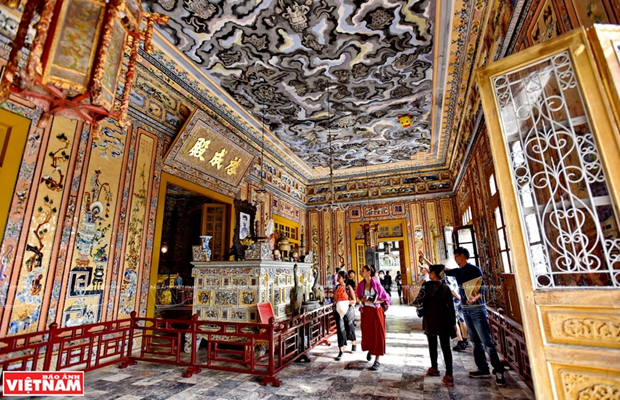Thua Thien-Hue (VNA) – The architecture of Khai Dinh’s tomb was considered remarkable by many generations, standing out from the traditional Nguyen Dynasty style by its innovation, originality and intricacy.
The Tomb of Khai Dinh, also known as Ung Lang (Ung Mausoleum), was built for King Khai Dinh, the 12th emperor of the Nguyen Dynasty (1885-1925). It is situated on the side of Chau Chu mountain outside Hue city, now belonging to Thuy Bang commune, Huong Thuy town.
Before building his tomb, King Khai Dinh consulted with many geomancers and then he finally chose Chau Chu mountain as the location for his mausoleum.
Work started on the tomb in 1920 and the construction lasted 11 years. The tomb was still unfinished when King Khai Dinh died in 1925. His son Bao Dai, the last emperor of Vietnam, finally completed the tomb in 1931.
Khai Dinh’s tomb is one of the most unique architectural features of the royal art in Hue city.
Compared to the tombs of the previous kings, the size of the Tomb of Khai Dinh is more modest, only about 5,000 square meters. However, this project is extremely elaborate.
From street level, visitors must climb up a series of steps to reach the tomb’s wrought-iron gate.
The tomb looks gray and imposing from afar. Emperor Khai Dinh chose to build his tomb out of modern materials like concrete and wrought iron. The tomb is also wired for electricity, a first in Hue tomb design.
Despite the Eastern design sensibility, a large dollop of Western influence can be seen in the details. The Emperor’s visit to the 1922 Marseilles Colonial Exhibition in France may account for the tomb design’s significant European influence.
After passing the gate, visitors enter a courtyard lined with the traditional left and right mandarins’ buildings constructed from reinforced concrete. Visitors must climb another 37 steps to reach the forecourt level preceding the mausoleum.
The steps leading up to the forecourt are “guarded” by two dragons, forming a sinuous set of banisters.
Veteran tomb-visitors note that Khai Dinh’s tomb is much smaller than his predecessors’ (the whole lot is about 1.3 acres in area, compared to Tu Duc’s massive, grandiose tomb site elsewhere). To make up for the size mismatch, the tomb’s designers must have seen fit to cram in much more elaborate detail in the space they had.
Two pillars flank the forecourt, also called the imperial audience court, which in turn directly precedes the octagonal stele pavilion that bears the imperial hagiography written by Khai Dinh’s successor.
Like the other royal tombs in Hue, Khai Dinh’s tomb also has an honor guard of stone bodyguards, mandarins, elephants, and horses. This honor guard, unlike the rest of the royal tomb, is carved out of stone, and occupy two rows on each side of the forecourt.
In the middle of the forecourt stands the octagonal stele pavilion commemorating Khai Dinh’s life and accomplishments. Like the rest of the tomb, the pavilion is made of reinforced concrete.
Another flight of stairs takes you to the apex of the entire tomb complex, the elaborate Thien Dinh Palace, which may be entered on the right side entrance (the front entrance is locked).
Compared to the gray grimness of the rest of the tomb, Thien Dinh palace looks gaudy and bright. The exterior is decorated in a flowery show of glass and porcelain that can best be described as “baroque”; the interior is no less gaudy.
The left and right rows – once reserved for tomb caretakers – now houses an exhibit of the Emperor Khai Dinh’s personal effects, including a gold chair, photographs of the Emperor’s life and times, and a rather martial-looking statue of the Emperor standing like a conqueror.
The walls are densely decorated and inlaid with elaborate glass and porcelain designs. The floor is covered with enameled flower bricks and the ceiling is painted with nine dragons, appearing in fine fleeting clouds.
Under a graceless, gold-speckled concrete canopy is a precious copper statue of King Khai Dinh reflecting the exact size of his which was molded in France in 1920 by two French artisans upon the request of King Khai Dinh and gilded by Hue artisans. His remains are interred 18m below the statue.
All of the inner decoration of the palace was made from glass and terracotta. They are royal pictures, tea trays, crown and many modern items such as alarm clocks, tennis rackets and kerosene which are shown here.
Skillful workers shape those materials into lively and bright artworks. Khai Dinh tomb becomes the skilled symbol as well as the pinnacle of porcelain and glass. It is worth being a structure bringing history – architecture – art value and having completely different style tombs of kings before.
According to experts, Khai Dinh tomb is the highlight of royal architecture at this time./.




